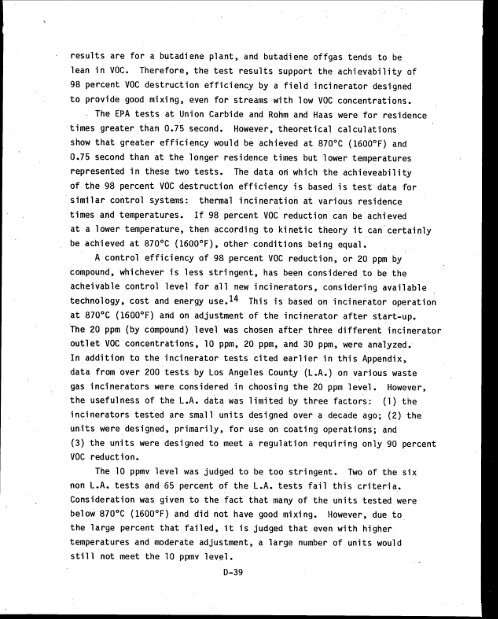Control of Volatile Organic Compounds Emissions from Manufacturing
Control of Volatile Organic Compounds Emissions from Manufacturing
Control of Volatile Organic Compounds Emissions from Manufacturing
You also want an ePaper? Increase the reach of your titles
YUMPU automatically turns print PDFs into web optimized ePapers that Google loves.
esuIts are for a butadiene plant, and butadiene <strong>of</strong>fgas tends to be<br />
1 ean in VOC. Therefore, the test results support the achievability <strong>of</strong><br />
98 percent VOC destruction efficiency by a fie1 d incinerator designed<br />
to provide good mixing, even for streams with low VOC concentrations.<br />
. The EPA tests at Union Carbide and Rohm and Haas were for residence<br />
times greater than 0.75 second. However, theoretical calculations<br />
show that greater efficiency would be achieved at 870°C (1600°F) and<br />
0.75 second than at the longer residence times but lower temperatures<br />
represented in these two tests. The data on which the achieveability<br />
<strong>of</strong> the 98 percent VOC destruction efficiency is based is test data for<br />
similar control systems: thermal incineration at various residence<br />
times and temperatures. If 98 percent VOC reduction can be achieved<br />
at a lower temperature, then according to kinetic theory it can certainly<br />
be achieved at 870°C (1600°F), other conditions being equal.<br />
A control efficiency <strong>of</strong> 98 percent VOC reduction, or 20 pprn by<br />
compound, whichever is less stringent, has been considered to be the<br />
acheivable control level for a1 1 new inci nerators, considering available<br />
technology, cost and energy use.14 This is based on incinerator operation<br />
at 870°C (1600°F) and on adjustment <strong>of</strong> the incinerator after start-up.<br />
The 20 pprn (by compound) level was chosen after three different incinerator<br />
outlet VOC concentrations, 10 ppm, 20 ppm, and 30 ppm, were analyzed.<br />
In addition to the incinerator tests cited earlier in this Appendix,<br />
data <strong>from</strong> over 200 tests by Los Angeles County (L.A.) on various waste<br />
gas incinerators were considered in choosing the 20 pprn level. However,<br />
the usefulness <strong>of</strong> the L.A. data was limited by three factors: (1) the<br />
incinerators tested are small units designed over a decade ago; (2) the<br />
units were designed, primarily, for use on coating operations; and<br />
(3) the units were designed to meet a regulation requiring only 90 percent<br />
VOC reduct ion.<br />
The 10 ppmv level was judged to be too stringent. Two <strong>of</strong> the six<br />
non L.A. tests and 65 percent <strong>of</strong> the L.A. tests fail this criteria.<br />
consideration was given to the fact that many <strong>of</strong> the units tested were<br />
below 870°C (1600°F) and did not have good mixing. However, due to<br />
the large percent that failed, it is judged that even with higher<br />
temperatures and moderate adjustment, a large number <strong>of</strong> units would<br />
still not meet the 10 ppmv level.<br />
D-39

















